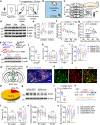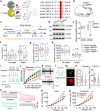The laterodorsal tegmentum-ventral tegmental area circuit controls depression-like behaviors by activating ErbB4 in DA neurons
- PMID: 33990773
- PMCID: PMC8590712
- DOI: 10.1038/s41380-021-01137-7
The laterodorsal tegmentum-ventral tegmental area circuit controls depression-like behaviors by activating ErbB4 in DA neurons
Abstract
Dopamine (DA) neurons in the ventral tegmental area (VTA) are critical to coping with stress. However, molecular mechanisms regulating their activity and stress-induced depression were not well understood. We found that the receptor tyrosine kinase ErbB4 in VTA was activated in stress-susceptible mice. Deleting ErbB4 in VTA or in DA neurons, or chemical genetic inhibition of ErbB4 kinase activity in VTA suppressed the development of chronic social defeat stress (CSDS)-induced depression-like behaviors. ErbB4 activation required the expression of NRG1 in the laterodorsal tegmentum (LDTg); LDTg-specific deletion of NRG1 inhibited depression-like behaviors. NRG1 and ErbB4 suppressed potassium currents of VTA DA neurons and increased their firing activity. Finally, we showed that acute inhibition of ErbB4 after stress attenuated DA neuron hyperactivity and expression of depression-like behaviors. Together, these observations demonstrate a critical role of NRG1-ErbB4 signaling in regulating depression-like behaviors and identify an unexpected mechanism by which the LDTg-VTA circuit regulates the activity of DA neurons.
© 2021. The Author(s).
Conflict of interest statement
The authors declare no competing interests.
Figures





Similar articles
-
Mesopontine cholinergic inputs to midbrain dopamine neurons drive stress-induced depressive-like behaviors.Nat Commun. 2018 Oct 25;9(1):4449. doi: 10.1038/s41467-018-06809-7. Nat Commun. 2018. PMID: 30361503 Free PMC article.
-
Dopaminergic Projection from Ventral Tegmental Area to Substantia Nigra Pars Reticulata Mediates Chronic Social Defeat Stress-Induced Hypolocomotion.Mol Neurobiol. 2021 Nov;58(11):5635-5648. doi: 10.1007/s12035-021-02522-7. Epub 2021 Aug 12. Mol Neurobiol. 2021. PMID: 34382160
-
ErbB4 signaling in dopaminergic axonal projections increases extracellular dopamine levels and regulates spatial/working memory behaviors.Mol Psychiatry. 2018 Nov;23(11):2227-2237. doi: 10.1038/mp.2017.132. Epub 2017 Jul 20. Mol Psychiatry. 2018. PMID: 28727685 Free PMC article.
-
Stress-induced plasticity and functioning of ventral tegmental dopamine neurons.Neurosci Biobehav Rev. 2020 Jan;108:48-77. doi: 10.1016/j.neubiorev.2019.10.015. Epub 2019 Oct 27. Neurosci Biobehav Rev. 2020. PMID: 31666179 Review.
-
Opioid-induced rewards, locomotion, and dopamine activation: A proposed model for control by mesopontine and rostromedial tegmental neurons.Neurosci Biobehav Rev. 2017 Dec;83:72-82. doi: 10.1016/j.neubiorev.2017.09.022. Epub 2017 Sep 23. Neurosci Biobehav Rev. 2017. PMID: 28951251 Free PMC article. Review.
Cited by
-
Rasd2 regulates depression-like behaviors via DRD2 neurons in the prelimbic cortex afferent to nucleus accumbens core circuit.Mol Psychiatry. 2025 Feb;30(2):435-449. doi: 10.1038/s41380-024-02684-5. Epub 2024 Aug 3. Mol Psychiatry. 2025. PMID: 39097664 Free PMC article.
-
MeHA: A Computational Framework in Revealing the Genetic Basis of Animal Mental Health Traits Under an Intensive Farming System-A Case Study in Pigs.Biology (Basel). 2024 Oct 21;13(10):843. doi: 10.3390/biology13100843. Biology (Basel). 2024. PMID: 39452151 Free PMC article.
-
A non-canonical GABAergic pathway to the VTA promotes unconditioned freezing.Mol Psychiatry. 2022 Dec;27(12):4905-4917. doi: 10.1038/s41380-022-01765-7. Epub 2022 Sep 20. Mol Psychiatry. 2022. PMID: 36127430 Free PMC article.
-
Single-Nucleus Transcriptomics of the Nucleus Accumbens Reveals Cell-Type-Specific Dysregulation in Adolescent Macaques with Depressive-Like Behaviors.Neurosci Bull. 2025 Jul;41(7):1127-1144. doi: 10.1007/s12264-025-01412-5. Epub 2025 May 21. Neurosci Bull. 2025. PMID: 40399551
-
Interleukin 13 signaling modulates dopaminergic functions and nicotine reward in rodents.Mol Psychiatry. 2025 Aug 7. doi: 10.1038/s41380-025-03137-3. Online ahead of print. Mol Psychiatry. 2025. PMID: 40775068
References
-
- Horvitz JC. Mesolimbocortical and nigrostriatal dopamine responses to salient non-reward events. Neuroscience. 2000;96:651–6. - PubMed
Publication types
MeSH terms
Substances
Grants and funding
LinkOut - more resources
Full Text Sources
Other Literature Sources
Medical
Molecular Biology Databases

